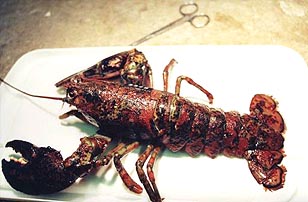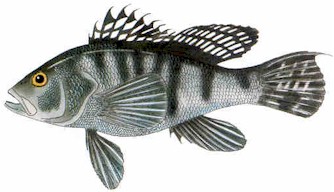American Lobster (3/6)
The Long Island Sound Lobster Blight / Shell Disease
There appear to be not one, but two causes for large die-offs of lobsters and other shellfish in Long Island Sound and surrounding waters. One appears to be an internal protozoan parasite and the other a bacterial disease of the shell. The protozoan disease seems to be confined as yet to Long Island Sound, where it has essentially wiped out the lobster population. Affected individuals show swelling in the mid-body, and many die soon after capture. The exact cause of the plague has not been isolated.

The shell disease is more widespread. Shell disease is more prevalent on larger, older lobsters, which molt less often. The resulting black pockmarks and scars on the claws and body are evident in the photo at right, and also at the bottom of this page. In especially bad cases, the shell may be eroded completely through, exposing the soft tissue beneath. Victims are often lethargic and slow, although the disease is thought generally not to be fatal. Shell disease is not supposed to affect the taste of the lobster, but the only affected one that I ever ate didn't taste very good, and I don't bother catching sick ones anymore.
Events like this are not unknown, having occurred off Canada, Maine, and New England in the past. Neither of these diseases appears to be dangerous to humans, but the decline of the lobster population and the reduced marketability of the remaining catch will probably affect the industry for years to come.
Explaining the Long Island Sound Lobster Die-off:
The Perfect Storm
August 1999 was unusual for commercial lobster fishers in Long Island Sound (LIS). Catches were unexpectedly dropping and large numbers of dead lobsters were being pulled up in the western part of the Sound. Dead lobsters were not limited to adults but also included sub-legals, molting lobsters, and berried (females bearing eggs) lobsters.
The situation did not improve in September. There was almost no fall run or fall molts in parts of the Sound. Hardshell lobsters were weak and lethargic with many lobsters dying within hours of being landed. Overall mortality increased and landings declined.
The situation worsened in October 1999 as the die-off spread to other organisms including blue crabs, rock crabs, spider crabs, sea urchins, and starfish. Wholesalers reported high mortality of lobsters within days of receipt. Landings continued to be lower than normal and lobster fishers also found berried lobsters molting, an unusual situation.
The die-off in western LIS had a significant economic and ecological effect on the lobster resource. Landings decreased anywhere from 64-99% in the western part of LIS Approximately 70% of the lobster fishers surveyed by the Connecticut Department of Environmental Protection (CTDEP) in western Long Island Sound lost 100% of their total income and the remainder lost 30% to 90% of their total income. The die-off continued into 2000 raising concern about the ability of the population to rebound. Surveys since 1999 have found low abundances of females and low numbers of larvae.
Lobster Biology
Lobsters are cold-blooded animals with an extreme sensitivity to environmental conditions that can alter their metabolism. LIS is the southern end of the commercial fishery of American lobsters and is near the limit of their inshore range (Factor and Clemetson 2003). Summer water temperatures in LIS can reach the upper margin of lobsters? tolerance limits, about 68? F. Lobsters can withstand higher temperatures, up to 35? C (95? F), however, when water temperatures go above 68F, lobsters' respiration rate increases, and the animal can become physiologically stressed.
Hypoxia (low dissolved oxygen) in the water column can also stress lobsters. Hypoxia often coincides with higher temperatures when lobsters need the most oxygen to maintain equilibrium. These conditions can lead to death, disruption of hormone systems, and reduced immunity to pathogens.
The Perfect Storm
Scientists identified four possible factors that contributed to the die-off: changes in water quality conditions including elevated temperatures and changes in dissolved oxygen levels; changes in environmental conditions such as pesticide levels or changes from storms; lobster crowding; and diseases.
In June 2001, Congress earmarked special funds for research on the lobster die-off. Over $3.5 million in federal and state of Connecticut research grants were awarded to 17 science research teams to investigate the causes behind the die-off. In October 2004, after three years of research, scientists summarized their results at the 4th Annual Lobster Health Symposium.
Scientists believe that a series of environmental factors and events combined to create habitat conditions leading to the die-off of lobsters in western LIS. Warmer water temperatures, low oxygen levels, overcrowding, and disease collectively contributed to the die-off of lobsters. Physical & Chemical Conditions Hypoxia, temperature, and rainfall all contributed to the die-off by making the lobsters physiologically stressed and more vulnerable to pathogens and chemical stressors. Increases in population densities and changes in land-use patterns have resulted in increases in nitrogen and silica, both indicators of eutrophication. Increasing air and water temperatures caused a decrease in the renewal of oxygen in the water leading to hypoxic conditions. Sediment samples confirm LIS waters were severely hypoxic just prior to the 1999 die-off.
Surface and bottom temperatures were higher than normal during the summer and fall of 1999. Lack of rainfall led to a highly stratified water column with slow estuarine circulation. Stratification was reduced by a strong mixing event, Hurricane Dennis, which stirred up a cold front and winds, causing the temperature at the bottom of LIS to rise by more than 2C in six hours.
Tropical Storm Floyd then dropped three inches of rain and caused heavy runoff from surrounding areas, leading to restratification of the water column and continued above-average water temperatures. Scientists conclude that the environmental conditions (higher water temperatures and low dissolved oxygen) present in the summer and fall of 1999 alone were enough to cause high lobster mortalities. The inability of the already stressed lobsters to tolerate the additional change in water temperature may have compounded the problem by inhibiting immune response.
Physiological (Immune & Endocrine) Responses Study
Lobsters show reduced immune function and disruption of hormone systems, such as the molting hormone, in late summer when water temperatures increase. In 1999, higher temperatures combined with hypoxic conditions left lobsters unable to physiologically cope with the changes in the environment and often led to death.
Disease
Some lobsters caught in 1999 were infected with the disease paramoebiasis. Amoebae were found in the nervous, glandular, and connective tissues of the lobsters. Scientists think that record-high lobster densities combined with higher water temperatures and hypoxic conditions promoted infection of lobsters with paramoebae. Long-term monitoring data suggest that increased bottom water temperatures also contributed significantly to the spread of disease.
Shell disease was known to cause death in lobsters in previous years but nowhere near the level of the die-off. Lobsters can generally respond to and fight shell disease but when the carapace is breached or ulcerated by the pathogen, internal lesions can lead to death. In normal environmental conditions, shell disease is not thought to cause mass lobster mortalities. Stressful environmental conditions, however, can make lobsters more susceptible to death from shell disease. Recent research by the Long Island Sound Lobster Initiative shows that few lobsters actually die from shell disease and it was not a major factor in the die-off. The disease still remains a priority in lobster research as it can compromise lobster health and marketability and is spreading to Rhode Island and Massachusetts.
In summer 2002, another lobster die-off occurred in the LIS Central Basin, although on a much smaller scale than the 1999 die-off. Scientists identified a new metabolic disease called calcinosis that may have contributed to lobster mortality. Calcinosis is an accumulation of calcium in lobster tissue, which in advanced stages affects the gills and causes the animals to suffocate.
Characteristics of a lobster suffering from calcinosis include an orange belly and rusty gills covered with abnormal growths. Preliminary results link the deaths in 2002 from calcinosis to a long period of warm bottom water temperature in LIS.
Pesticide Concentrations
Researchers also explored the possibility that higher levels of pesticides in LIS caused the die-off. Some lobster fishers believed that pesticides used to combat the West Nile virus caused the lobster die off. Both New York and Connecticut sprayed pesticides in the summer of 1999 to kill mosquitoes that might carry the West Nile virus. Over 100 lobster fishers filed a class action suit against pesticide manufacturers, contending that the lobsters were exposed to high levels of pesticides washed into LIS after a four-day period of heavy rains from Tropical Storm Floyd. Researchers measured mortality and immune response to three pesticides likely to be found in LIS in larval and juvenile lobsters: methoprene, malathion, and resmethrin. Methoprene bioaccumulated in tissues of lobsters but models suggest that the maximum concentration in LIS was well below the threshold for effects in lobsters. The maximum malathion concentrations found in LIS in bottom waters were not within the range of concentrations having effects in lobsters. Studies show that resmethrin has several lethal and sublethal effects in lobsters. Modeling of pesticides levels suggests that maximum concentrations in LIS surface and bottom waters may have had lethal effects on larvae and sublethal immune effects on adults in a few localized embayments. Scientists still need to study the possible impact of the pesticide sumithrin as a stressor in limited areas.
Habitat Conditions
LIS habitat is changing. Periods of hypoxia are now a regular, annual feature in late summer and appear to be lasting longer each year. Scientists warn that the conditions leading up to the die-off in LIS could happen again and could affect other organisms. Clams, oysters, and finfish have also experienced mortality incidences but not as significant as the lobster die-off.
In 1994, the Long Island Sound Study (LISS) completed a Comprehensive Conservation and Management Plan that identified seven management issues: (1) hypoxia, (2) toxic contamination, (3) pathogen contamination, (4) floatable debris, (5) living resources and habitat management, (6) land use and development, and (7) public involvement and education.
In 2003, the U.S. Environmental Protection Agency, New York, and Connecticut signed the 2003 Long Island Sound Agreement reaffirming the 1994 agreement and identifying specific management goals. Some of the goals include eliminating or reducing hypoxia, reducing bioaccumulation of contaminants in living resources, cleaning up contaminated sites that contribute to pollution, and restoring the ecological functions and health of lost and degraded habitats. Agencies involved in managing LIS understand maintenance of the habitat is critical to helping the lobster population rebound.
ASMFC Efforts
The Atlantic States Marine Fisheries Commission's (ASMFC) Lobster Health Steering Committee is working to continue research regarding the causes and effects of lobster diseases and for monitoring lobster health over the entire range of the resource. For more information see the NY/CT Sea Grant's Long Island Lobster Initiative website at "https://seagrant.sunysb.edu/LILobsters.
Sources:
NY/CT Sea Grant, ASMFC.
Connecticut Department of Environmental Protection. 2001.
Information Regarding the Impact Of 1999 Lobster Mortalities In Long Island Sound.
Factor, J.R. and A. Clemetson. 2003. Life as a Lobster in Long Island Sound: Biology and Life Cycle.
Lobster Health News Supplement, Joint Publication of the Sea Grant College Programs of Connecticut and New York.

See Lobstering for some pointers on catching and cooking lobsters.
See Catch Restrictions for catch limits.


